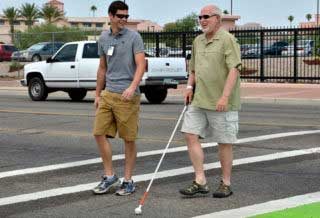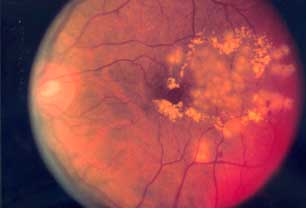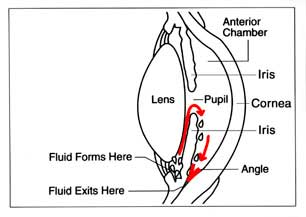Telehealth Reverse Diabetes and Prevent Loss of Vision | Free Trial in Texas

Diabetes is the leading cause of complete blindness in the U.S and increases loss of vision from any cause.
Control of blood glucose and HbA1c is not enough! It is essential to reduce fat in the abdominal cavity and maintain skeletal muscle mass.
Maximum Waist Circumference is a critical measure of success or failure preventing loss of vision.
Damage To Microcirculation
- Retinopathy (loss of vision)
- Nephropathy (chronic kidney disease)
- Neuropathy (pain, numbness, weakness)
Too much body fat and not enough skeletal muscle cause fat tissue to release factors which damage eye, kidneys and nerves.
Fat tissue secretes growth factors (GF) that form new blood vessels to supply newly formed cells. The greatest effect of GFs is right in the fat tissue but they also spill into the general circulation. From there, GFs cause expansion and formation of new arteries in many organs. Including small retinal arteries in the back of each eye.
Fat tissue in the abdominal cavity secretes much more GF than fat tissue under the skin. That’s why decreasing maximum waist circumference is so important. The more fat there is in the abdomen the more GFs are circulating to organs all over the body. Including eyes, kidneys and nervous system.
 Damage to microcirculation can be seen in the eyes before there’s any loss of vision. In fact, damage can be seen before there’s even any change in levels of glucose circulating in the blood (BG) or attached to red blood cells (HbA1c).
Damage to microcirculation can be seen in the eyes before there’s any loss of vision. In fact, damage can be seen before there’s even any change in levels of glucose circulating in the blood (BG) or attached to red blood cells (HbA1c).
Sometimes, the first hint of diabetes comes from examining the eyes with an ophthalmoscope or a retinal camera. Microaneurysms on small retinal arteries tell the story.
That’s when it’s time to take in fewer calories and do more exercise.
Common Causes Of Vision Loss
 Diabetic retinopathy is the most common cause of vision loss among people with diabetes and a leading cause of blindness among working-age adults.
Diabetic retinopathy is the most common cause of vision loss among people with diabetes and a leading cause of blindness among working-age adults.
One-third of men and women over 65 years have loss of vision enough to limit activities of daily living. The four most common causes are macular degeneration, glaucoma, cataracts and diabetic retinopathy.
Blurred Vision
Uncontrolled diabetes distorts vision.
 High levels of glucose can change fluid levels in the eyes and swelling of eye tissues. The result is blurry vision. If levels of glucose keep changing during the day, eye glasses will correct vision at a certain level but not at others. This type of blurry vision goes away when levels of glucose in the blood come under control at normal levels and eye glasses are adjusted to match the anatomy of lens and cornea.
High levels of glucose can change fluid levels in the eyes and swelling of eye tissues. The result is blurry vision. If levels of glucose keep changing during the day, eye glasses will correct vision at a certain level but not at others. This type of blurry vision goes away when levels of glucose in the blood come under control at normal levels and eye glasses are adjusted to match the anatomy of lens and cornea.
Diabetic Retinopathy (DR)
Diabetes damages circulation of the eyes.
Damage to the retinal blood vessels is the most common cause of vision loss in people with diabetes. It is also the leading cause of blindness in middle-aged men and women. About 6% of diabetics actually go blind. Fortunately, loss of vision can be prevented by prompt treatment.
The earliest stage of DR has small swellings in retinal arteries. These are called microaneurysms and can be seen with an ophthalmoscope or retinal camera. At this stage, some of the swellings may leak fluid into the retina. The fluid deposits usually clear up and don’t affect vision. Sometimes, fatty deposits remain and they can affect vision.
 At the next stage of DR, the small distorted arteries become blocked. Some regions without enough blood become scarred and lose light sensitivity. Other regions have vessels that break and cause hemorrhages. All this can be seen with an ophthalmoscope or retinal camera.
At the next stage of DR, the small distorted arteries become blocked. Some regions without enough blood become scarred and lose light sensitivity. Other regions have vessels that break and cause hemorrhages. All this can be seen with an ophthalmoscope or retinal camera.
As areas lose blood supply, they secrete their own growth factors (GF) and grow many more new blood vessels. These new vessels are fragile and break down easily. More scarring, more hemorrhage and more loss of vision.
When scarred tissue contracts, the retina gets pulled away from the back of the eye and vision loss becomes permanent.
Diabetic Macular Edema (DME)
Diabetes may cause permanent loss of vision.
 The macula is an oval-shaped pigmented area near the center of the retina. This is the area responsible for the central, extra-sharp, high-resolution, color vision that is possible in good light. When blood vessels bleed or leak fluid into the macula, it gets swollen and loses sensitivity to light.
The macula is an oval-shaped pigmented area near the center of the retina. This is the area responsible for the central, extra-sharp, high-resolution, color vision that is possible in good light. When blood vessels bleed or leak fluid into the macula, it gets swollen and loses sensitivity to light.
DME causes loss of vision in about half of all people with diabetic retinopathy.
Glaucoma
Diabetes increases pressure in the eyes.
 When growth factors circulating from fat tissue, new blood vessels grow on the iris, the colored part of the eye. The new vessels close off the fluid flow in the eye and raise the eye pressure, called open-angle glaucoma.
When growth factors circulating from fat tissue, new blood vessels grow on the iris, the colored part of the eye. The new vessels close off the fluid flow in the eye and raise the eye pressure, called open-angle glaucoma.
Diabetes increases the likelihood of glaucoma by about 40%. However, circulating growth factors can cause glaucoma even without elevated blood sugar.
Increased eye pressure obstructs the flow of blood into the retina. Vision is lost when photoreceptors and nerves are damaged by glaucoma.
Cataracts
Uncontrolled diabetes clouds the lens of the eye.
 The eye’s lens is clear early in life but gradually becomes cloudy during life. In diabetes, high levels of glucose in the blood cause high levels in the fluid compartments of the eyes. Those high levels spread into the lens and cause natural proteins to become cloudy.
The eye’s lens is clear early in life but gradually becomes cloudy during life. In diabetes, high levels of glucose in the blood cause high levels in the fluid compartments of the eyes. Those high levels spread into the lens and cause natural proteins to become cloudy.
A cloudy lens is called a cataract. It scatters and blocks the light as it passes through the lens, preventing a sharply defined image from reaching the retina. Objects appear faded and blurry with distorted focus.
How To Prevent Loss of Vision
 Ask your personal physician to examine your eyes by ophthalmoscope and check for microaneurysms. You may get an early warning about damage to the microcirculation of eyes, kidney and nerves.
Ask your personal physician to examine your eyes by ophthalmoscope and check for microaneurysms. You may get an early warning about damage to the microcirculation of eyes, kidney and nerves.
If you are overweight, obese or have diabetes get your eyes checked every year by an ophthalmologist.
If you are overweight, obese or have diabetes, control of blood glucose and HbA1c is not enough. It is essential to reduce fat in the abdominal cavity and maintain skeletal muscle mass.
Reducing fat in the abdominal cavity will reduce maximum Waist Circumference. The more fat there is in the abdomen the more growth factors are circulating to organs all over the body. Including eyes, kidneys and nervous system.
Regular muscle endurance and strength training will maintain skeletal muscle mass and increase insulin sensitivity during physical activity.
 Contact us (by clicking the messenger icon in Lower Right Corner of web page) and we’ll help you Reverse Diabetes and Prevent Loss of Vision.
Contact us (by clicking the messenger icon in Lower Right Corner of web page) and we’ll help you Reverse Diabetes and Prevent Loss of Vision.
One Small Request:
If you enjoyed reading this article, do comment below and give it a share. Your share is extremely helpful to spread our message and help more like you.




